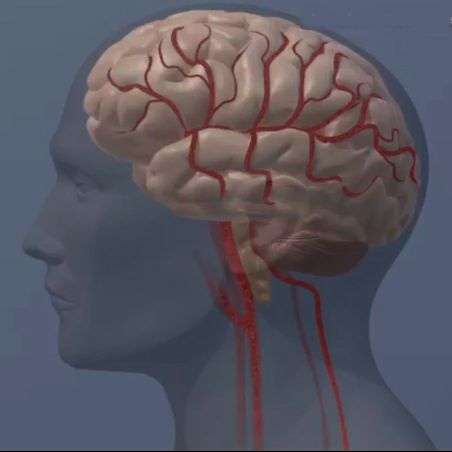Brain image. Credit: American Heart Association
Every 30-minute delay in breaking up a blood clot from a stroke was associated with a 10 percent decrease in the probability of a good outcome, regardless of other factors such as stroke severity, according to late-breaking research presented at the American Stroke Association's International Stroke Conference 2013.
The study, a subset from a larger trial, included patients who received both intravenous tissue plasminogen activator (tPA) and endovascular therapy, and had blood flow restored within seven hours of stroke onset.
The patients were part of the Interventional Stroke Management III trial (IMS 3), presented earlier in the conference, in which intravenous tPA alone and with added endovascular therapy were compared, but neither proved superior. Delivered through a vein in the arm tPA is the only emergency stroke treatment proven to improve outcomes. It must be given within 4.5 hours of symptom onset and faster start of treatment leads to better recovery.
Endovascular therapy involves inserting a catheter directly into a blocked artery in the brain to deliver clot-busting drugs or to use a device to remove the clot. This treatment is usually used after the 4.5-hour time window for intravenous tPA has closed, or for bigger or more stubborn clots that don't dissolve with other treatments.
The importance of timing using endovascular therapy hasn't been as well studied, said study author Pooja Khatri, M.D., M.Sc., director of acute stroke and associate professor of neurology at the University of Cincinnati in Ohio.
IMS 3 was a multicenter international trial in which about 900 participants with ischemic stroke were to be randomly assigned to receive tPA alone or tPA plus endovascular therapy. Everyone received tPA within three hours of stroke onset. The trial was stopped in April 2012, with about two-thirds of intended patients enrolled, after an interim analysis determined the additional therapy was highly unlikely to benefit patients.
In the sub-study, researchers examined data on 240 patients who received both intravenous and endovascular therapy in IMS 3 who had major clots in brain arteries. Among these patients, blood flow was restored in 182 patients within seven hours from stroke onset. Patients were evaluated for level of disability 90 days after treatment.
Time proved critical regardless of other factors, such as absence of a disability prior to stroke, stroke severity, or the results of the patients' scans before treatment.
"We have effective endovascular treatments for unblocking arteries, but as far as actually making stroke patients clinically better, we need to move a lot faster," Khatri said. "There's a window of time that we have during a stroke and if we pass that point, it's the point of no return in terms of brain damage. For endovascular therapy to work we may need to deliver it more quickly, and that is what future trials need to test. If we had opened arteries faster in the IMS 3 trial, we might have had a positive trial that brought a more effective treatment to patients with severe strokes."
Delays, said Khatri, include patients not recognizing the signs of a stroke, family members driving patients to the hospital instead of calling emergency services (9-1-1), emergency departments being too slow in identifying or evaluating a stroke for treatment, and delays in transferring patients to a hospital or facility with expertise in endovascular therapy.
"In the future, we may also be able to use MRI and CT scans to take images of a patient's brain to identify whose treatment window is closing, those who have a little more time, or those with the types of clots most likely to benefit from endovascular therapy. These approaches are under investigation. But, even for those with favorable scans, we can't get away from the fact that the clock is ticking and an acute stroke patient needs to be managed with the highest level of urgency."
Provided by American Heart Association



















